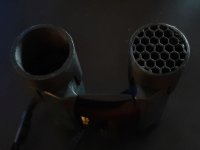pbjosh
missing the neotropics

Henry Link appears to be right that some of the glare can be blocked as far as 8-10" from the objective. So, I expect any kind of shroud will reduce some of the glare, but probably not all of it.
For a sea watch or pelagic trip, I wonder if polarizing lenses or simply sunglasses might do the trick.
-Bill
I agree that all binoculars will show glare in the worst circumstances. Also agree that polarized glasses are absolutely amazing for pelagic birding (with the caveat that you sometimes get weird interactions with some binoculars, presumably due to the coatings in use - ie, my Maui Jim prescription sunglasses combined with my SFs give weird bronzy / purply sheens to the water in some conditions; this doesn't occur with the same sunglasses and my ELs).
As far as these glare / reflection blockers, I doubt you can ever effectively block all the glare, but you might be able to block a good part of it, particularly on binoculars that do not inherently deal well with glare. The question is how long the tubes have to get relative to their diameter in order to exclude more off-angle stray light than the binocular's / telescope's inherent internal design and baffling / darkening can reject. Essentially you are scaling down and implementing smaller versions in parallel of Henry's stated 8-10" shroud length necessity. So you scale down 8-10" length for one long tube to 1" for each of your tiny tubes, and you scale down 42mm objective size to 4mm internal straw diameter and you've achieved the same degree of excluding off-axis light (and I should think with less vignetting to boot). The advantage vs inherent stray light rejection must of course vary from model to model as well. It would be interesting to experiment with this. I also wonder, though, if the black straws are really the best material - a plastic straw is not a matte finish, they tend to be a bit reflective to my layman's eye. Not sure I can think of a better material though, and I doubt anyone is selling thin walled Vantablack tubes that I can find on Amazon
Last edited:






